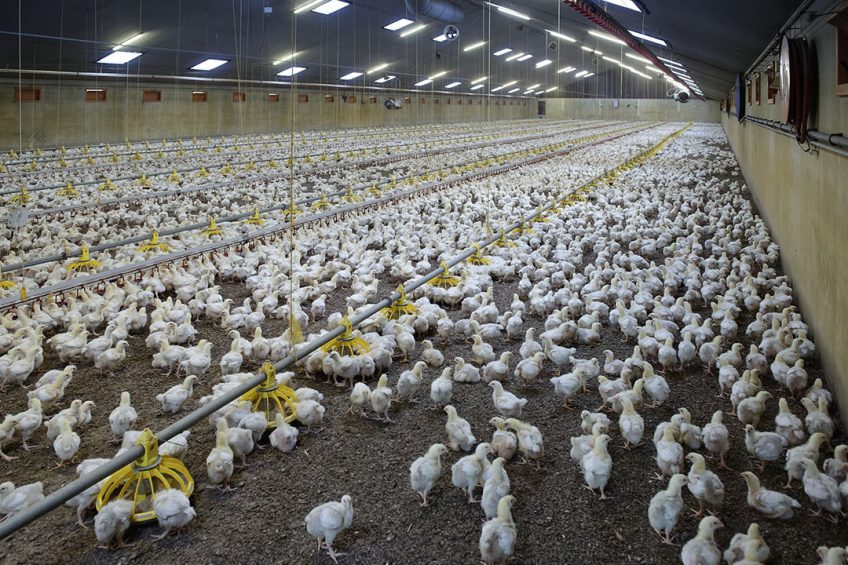Effects of stocking density on broiler production parameters

Here we look at the effects of stocking density, one of the most important stress factors affecting production and yield in poultry farming.
High stocking density causes reduced feed consumption, lower growth rates and poor-quality carcasses. Besides, high stocking density may be associated with a surge in airborne pathogens.
Feed intake and conversion
A reduction of feed intake in response to increasing stocking density is often reported to be the result of feed restriction. The heat stress resulting from the increased temperature inside the litter and in between the birds with higher stocking densities, along with the increased level of ammonia, is also a factor contributing to reduced feed intake even though the feeder space per bird is kept constant. The reduced feed intake may result in better feed conversion when stocking density increases, but in many cases, feed conversion may not be affected and may even be worse.
Growth rate
There is a general tendency towards reduced growth rates with higher stocking densities not only because of the reduced feed intake under such conditions, but also because of the loss of feed energy as a result of immunological responses and other body adjustments. The reduced growth rate may further be attributed to the disruption in the gut micro-flora which help in digestion, absorption of nutrients, and improvement of intestinal microarchitecture. The critical value, however, varies between the experiments. When the stocking density increased from 18.4 to 28.6 kg/m² there was no depression of growth rates, but when the stocking density was raised to about 32 kg/m² or more, the slaughter weight was significantly lower. In many cases, however, this problem has been alleviated by increasing ventilation rates.

Carcass quality
High stocking density has negative effects on the length, width, and depth as well as the mass of the breast meat, which is reduced by about 12 grams in each bird. It also affects the length of tubular bones, the development and roundness of the breast, and the development of the hind extremities. These effects were confirmed in both sexes, but were more pronounced in males compared to females, indicating a significant effect of sex on the conformity of broiler carcasses reared under different stocking densities. The quality of broiler carcasses is also diminished because of deformed and broken legs. The reduced physical activity of broilers and the mechanical injuries at high stocking densities are considered to be key factors contributing to this problem and the insufficient development and maturity of the skeleton in general.
Litter quality
The high stocking density also affects the microbial profile of the litter, particularly in the case where the litter material is not sufficiently dry and friable. In one study, the mould count (105) increased from 0.6 to 1.3 in the litter at stocking rates of 10 and 17 chickens/m², respectively. Inhalation of a greater amount of toxins produced in the heavily contaminated litter resulted in numerous productivity problems. it reduced the levels of lipase, amylase, trypsin, and chymotrypsin enzymes, which leads to insufficient digestion and absorption of protein, fat, and carbohydrates and hence affects the use of these nutrients for growth and other biological functions.
 How to ensure litter quality?
How to ensure litter quality?
Depending on region and climate conditions, the floor in the broiler house can differ, as can the availability of litter material.
Skin and feather cover
Increased stocking density has, in many cases, resulted in increases in dermatitis, skin lesions and scratches. Feathering also begins to deteriorate at a density of 30 kg/m², probably due to increased feather pecking and the degree of litter caking, which reduces the chance for dust bathing behaviour and hence prevents birds from keeping their feathers clean and free of parasites. This may be part of the reason for the increased number of scratches observed in birds housed at higher stocking densities. Stocking density, the strain of birds, and the degree of feathering could all be considered as potential risk factors for abdominal scratches in broiler chickens. A significant increase in the incidence of breast blisters in females, with a similar trend for males, has been demonstrated in birds reared at high stocking densities.
Diseases
The increased stocking density may lead to increased levels of airborne dust and hence more respiratory diseases and can lead to the incidence of other disease problems such as ascites and contact dermatitis. It was also found that high stocking density resulted in adrenal hypertrophy, suggesting that birds at high stocking densities may be immunocompromised. This is probably the cause of the reduced immune responses observed at high stocking densities. Birds housed at lower stocking densities (10 or 14 birds/m²) had a greater antibody response to Newcastle disease than birds housed at 18 birds/m².
 Health tool
Health tool
Find out more about the causes and effects of a wide variety of poultry diseases in the Poultry World health tool.
Economics
Increasing stocking densities in broiler production is usually done to maximise economic returns from a production unit, but this objective may not always be achieved. There is an optimum stocking density that will maximise economic returns, but this varies, depending on the environmental conditions and management of the birds. Birds raised at high stocking densities must receive adequate feeder and drinker space. Proper ventilation and cooling systems should also be provided to reduce temperature, CO2, and ammonia levels which affect growth and health performance. In this case, the stocking density can be increased from 10-12 birds/m² to 15-17 birds/m², thus increasing the total capacity of the farm by about 30% with no detrimental effects on performance. From an economic standpoint, the increased farm capacity with feeder/water space, ventilation, and cooling systems would cost only 40% of the funds needed to establish a new poultry house.
References are available from the author on request.
 Beheer
Beheer











 WP Admin
WP Admin  Bewerk bericht
Bewerk bericht